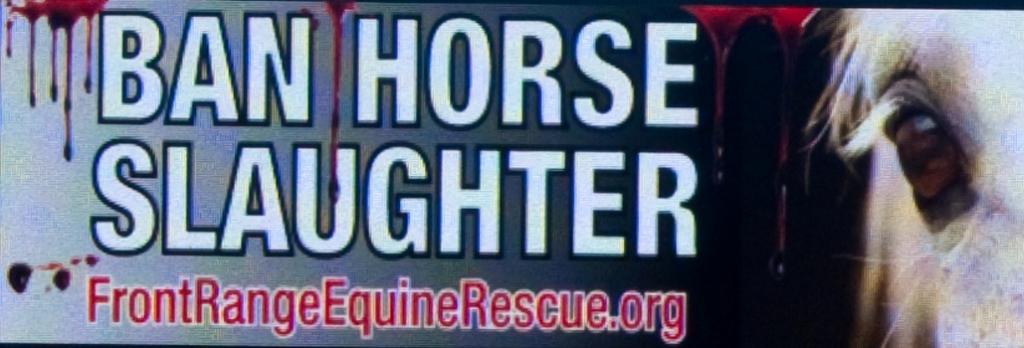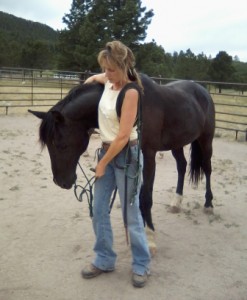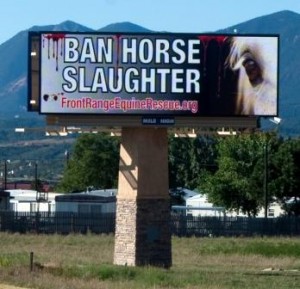
Slaughter Kills the Horse Industry
By Hilary Wood, President and Founder, Front Range Equine Rescue
Approximately 1% of America’s horses are slaughtered annually for human consumption. Prior to 2007, three plants operated in the U.S. to butcher tens of thousands of horses for dinner plates in Europe and Asia. While U.S. plants operated, thousands of America’s horses also crossed the borders into Canada and Mexico for slaughter. These were generally blind, crippled, and sick horses along with stallions and mustangs. The U.S. plants stopped operating in 2007 and now all U.S. horses are slaughtered in either Mexico or Canada. The annual number of horses slaughtered remains around 120,000 to 130,000.
Too many people are under the impression that slaughter is a way to get rid of old or unusable horses. This couldn’t be farther from the truth. Studies have shown that over 92% of slaughter bound horses are considered in good condition; the average age of horses killed for meat is in the 3 to 7 year old range.
American horses are not raised as a food animal. Their flesh (meat) is full of products and medications given to them over the course of a lifetime. U.S. horse meat is tainted by these substances and unsafe for human consumption. Labels on medications, wormers, vaccinations, fly sprays, numerous supplements, and other products clearly state “not for use in animals intended for human consumption.” Horse owners do not have complete medical histories and records of horses from birth, thereby making it impossible to trace what dangerous substances have entered a horse’s system. There are little to no studies or research for withdrawal periods for potentially toxic substances either ingested or topically applied to horses. In a legal petition to both FDA and USDA, Front Range Equine Rescue outlined over 110 substances dangerous or toxic to humans and found in commonly used horse products and medications.
Economically, horse slaughter makes no sense. Consider the tens of thousands of dollars spent for one horse over the course of its lifetime. Just the basics of feed/hay, vet and farrier services, and shelter expense amount to thousands of dollars annually. Start to factor in whether you pay a boarding facility to keep your horse vs. did you purchase property to house the horse with you and the expenses increase. If you purchased property, you have the cost of a barn (or other shelter), fencing, corral area(s), and maybe an arena. You will have feed pans, buckets, muck rakes, cart or wheelbarrow, possibly shavings and stall mats and other equipment. Are you purchasing a truck and trailer? Are you investing in riding lessons, clinics or joining an equestrian related club? Don’t forget tack, grooming items, and apparel. The list can go on and on. The bottom line is that the horse industry needs every horse owner to survive.
The revenue generated by horse owners and related businesses totals billions of dollars each year. Foreign-owned slaughter plants in the U.S. might make millions for a few investors, yet as little as $5 in tax revenue was paid in one Texas town where a former plant was located. Videos and other documentation clearly show rampant abuse of horses in the slaughter pipeline as well as environmental, waste and other health hazards resulting from slaughter plants.
Front Range Equine Rescue (FRER) contributes tens of thousands of dollars each year to the horse industry – showcasing one example of how horses contribute to a thriving horse industry without slaughter. For instance, FRER uses several sources to buy feed, provide veterinary care, and farrier services for the 55-65 horses in its rescue program. FRER also spends funds on horse care supplies including buckets, feed pans, tack, grooming supplies, fly sprays, medications, leg wraps, stall mats, etc. FRER has also purchased trucks/trailers, property, buildings, corrals, and fencing, and created seasonal employment. Other expenditures have included payments to states for registrations and other non-profit requirements, repairs, maintenance, postage, mailers, office supplies, auctions, events with other guests and vendors, and training.
Front Range Equine Rescue has served as a role model for programs to meet the challenge of successfully ending horse slaughter and creating better opportunities for horses. Since 2002, FRER has offered a partial reimbursement program for gelding stud colts and stallions. In 2007, FRER initiated a “Trails End” program to give a partial reimbursement for humane euthanasia when needed. By 2010, Front Range implemented several horse owner assistance programs utilizing grant money to give a one-time hand up (not hand out) to responsible horse owners in financial difficulty. FRER has assisted numerous owners with education on safe tips for re-homing horses.
How does a slaughtered horse contribute to maintaining a thriving horse industry? It does not. When it is time to humanely say goodbye to a beloved equine friend, an equine veterinarian is the one to call. There are also businesses which provide disposal or burial services – expenses which go to help equine-related businesses and keep revenue in the U.S. horse industry, not to a foreign slaughter house owner.
While today’s economy still struggles to recover from the Great Recession, the negative financial impact is still rippling through the horse industry. Many owners have been forced to give up their horses, while others look for ways to afford ever increasing prices for hay, feed, vet and farrier care, and other supplies. However, there are notable signs of improvement also. Attendance at horse shows and related events are on the rise again. New owners are purchasing horses or adopting from rescues. There is an increase in equine-assisted therapy and wounded warrior programs. To meet today’s challenges in the horse community there are more hay/feed banks, gelding and euthanasia assistance programs as well as education on safely re-homing a horse. Re-training of off-the-track Thoroughbreds and training programs for wild mustangs result in better placement for horses usually facing slaughter. Providing incentives to stop over breeding and irresponsible breeding is key to controlling the horse population. The basic economic principle of supply vs. demand should determine horse values, not some “bottom price” in the slaughter market. The horse industry should look to broaden its support among the non-owning, but horse loving, community as a viable revenue source as well.



